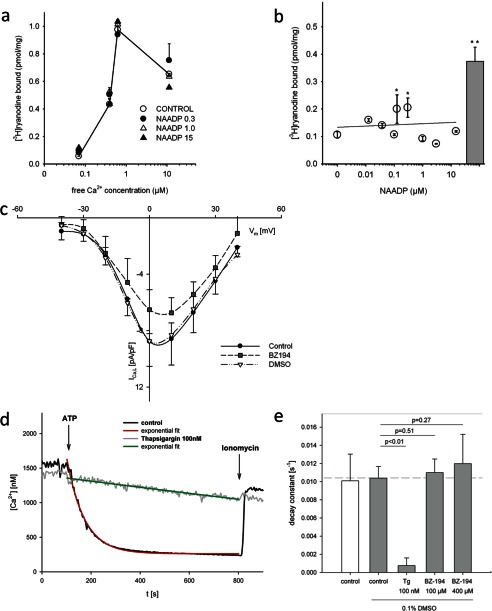FIGURE 2.
Lack of off-target effects of BZ194 in murine ventricular cardiac myocytes. a, effects of BZ194 of [3H]ryanodine binding to RyR2 was analyzed. Specific high affinity [3H]ryanodine binding to cardiac sarcoplasmic reticulum was carried out at various free Ca2+ concentrations in the absence and presence of NAADP (0.3, 1, and 15 μm). Symbols indicate the mean ± S.D. of a typical experiment, which was repeated two times. b, [3H]ryanodine binding analyzed at increasing concentrations of NAADP at 70 nm free [Ca2+]. Bar shows Ca2+ release by 20 mm caffeine as a positive control. Data are presented as mean ± S.E. (n = 2–13). Asterisks indicate statistical significance (p < 0.05). Statistical significance versus control was calculated for multiple comparison by analysis of variance (ANOVA) and post hoc Dunnett test. c, effect of BZ194 on cardiac L-type Ca2+ channels was analyzed in whole-cell patch clamp experiments. The current density-voltage relationship showed a statistically not significant reduction in current density, when cardiac myocytes were preincubated with BZ194 (2 mm) as compared with incubation with vehicle DMSO (0.5%, v/v). Data are presented as mean ± S.E. (n = 3–5). A two-factor ANOVA model with backwards selection followed by least significant difference post hoc tests was applied to investigate the effect of control, DMSO, BZ194, and different membrane potentials and their interactions on current density. d, effect of BZ194 on Ca2+ uptake in permeabilized cells was analyzed. The effect of BZ194 on Ca2+ uptake was analyzed in permeabilized HEK293 cells. Characteristic curves for control (black) and 100 nm thapsigargin (gray) as control for SERCA inhibition are shown. Ca2+ uptake was activated by addition of ATP. Curves were fitted by three parameter exponential decay (tracings in red and green, respectively). Addition of ionomycin after 800 s released Ca2+ from luminal space. e, reciprocal time constant showed no statistically significant effect, when BZ194 (100 or 400 μm) was added to HEK293 cells as compared with vehicle DMSO (0.1%, v/v). Tg, thapsigargin. Data are presented as mean ± S.E. (n = 4–10). Significant differences are indicated by p < 0.01, Student's t test.

